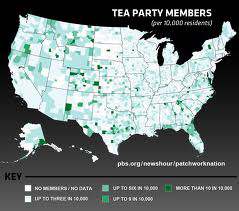The Tea Party Comes Out

A fear of diversity is at the center of Tea Party anger, argues The White House Project’s Marie Wilson—the very quality that produces good decision-making and the innovation that is likely to pull us out of the Great Recession.
For several months Americans have watched the Tea Party movement grow and have asked, “What do these groups really want?” When they purported to be against healthcare reform (what they called, “Obamacare”) but carried signs that read “Get your government out of my Medicare” and “Take our country back,” it didn’t make sense. And the Tea Party protesters we’ve seen on the news aren’t talking about the traditional firebrand issues of abortion and gay rights either. Actually, during the healthcare debates, they didn’t seem to have any solid policy issues at all, just anger. But when the racial and homophobic epithets started to fly, the plot thinned.
Frank Rich nailed it in his March 28 New York Times piece, “The Rage Is Not About Health Care.” As he said, it’s about the “real changes in America that can’t be repealed,” and he made a clear, historically based case about just what the ethnically homogeneous Tea Party members are afraid of losing: the dominance of white people in the United States. It’s the same fear that the passage of the 1964 Civil Rights bill evoked.
Citing the folks who so visibly and recently represent this change (President Obama, Speaker Pelosi, and Justice Sotomayor), Rich also argues that the issue didn’t have to be healthcare, but that any inaugural piece of legislation would have elicited these “fears of disenfranchisement among a... dwindling and threatened minority in the country no matter what policies were in play.” It is no surprise that those legislators who were singled out first with slurs and spit, like Representatives John Cleaver and Barney Frank and, the lion of the House, Representative John Lewis, are well-known African-American and gay leaders in Congress. I agree with Rich in his assessment that when the Tea Party folks signal whom they “want to take the country back from,” it is representatives like Cleaver, Frank and Lewis, and their prime target, Nancy Pelosi, whom they are talking about.
As someone who grew up in Georgia in the forties and fifties and worked in the civil rights movement in the sixties, I recognized in Sarah Palin's terse rhetoric during the presidential campaign, as Rich did, language that served as bait and evoked cries of Obama as a “traitor” and actual calls to take Obama's life. This rhetoric ostensibly paved the way for the post-election Tea Party movement. Palin’s actions then and now show that beyond her lack of knowledge about politics and policy, her lack of understanding of history and culture is more dangerous. I truly doubt she grasps the fire she is playing with, and I pray that powerful people in her party will not follow McCain’s lead in joining her in these references, and will instead advise her to cut out her language about “reload” and the gun-related images on her website.
While I disagree with the Tea Partiers actions, I don’t want to diminish the real anger and fears that Americans who aren’t taking tea, but are suffering and need some way to participate in our democracy. I also understand that they see very few open avenues that will permit them to constructively vent their frustrations.
Those of us who are still employed have a responsibility and a mandate to help make the needed changes. We also have the duty to keep the intensity down by talking about the real promise this growing diversity in our country, and across every branch of our government, holds for a more prosperous union. New research actually shows that a diverse group of people will make a better decision than a group of experts, because as one of the leading researchers, Scott Page says, “we are all stuck at different places.” It is this variety of orientation and perspective that breeds innovation.
The paradox here is that the rich diversity of people the Tea Party fears could be the key to pulling us out of this economic slump, which was created by in large by groups of wealthy white men from very similar backgrounds.
As the leader of The White House Project, I see daily the repercussions of our failure to use the resources represented by American's women who cross all of these diverse areas, and I know what we are missing out on. For instance, as our recently released Benchmarks Report revealed, women led only 3 percent of the Fortune 500 companies and hold fewer than 17 percent of the executive positions in those companies, even though research shows that profits at Fortune 500 firms that most aggressively promoted women were 34 percent higher than industry medians.
As Frank Rich noted, there are real changes in American life that cannot be repealed, but that can be used to foster a better life for all of us, if we remember what Franklin Roosevelt said long ago, “We have nothing to fear but fear itself.”
For another WMC Exclusive posted today, click on “The Tea Party Movement—Taking the Pulse,” a report and analysis by Peggy Simpson.
More articles by Category: Economy, Health, Immigration, Politics
More articles by Tag:


























